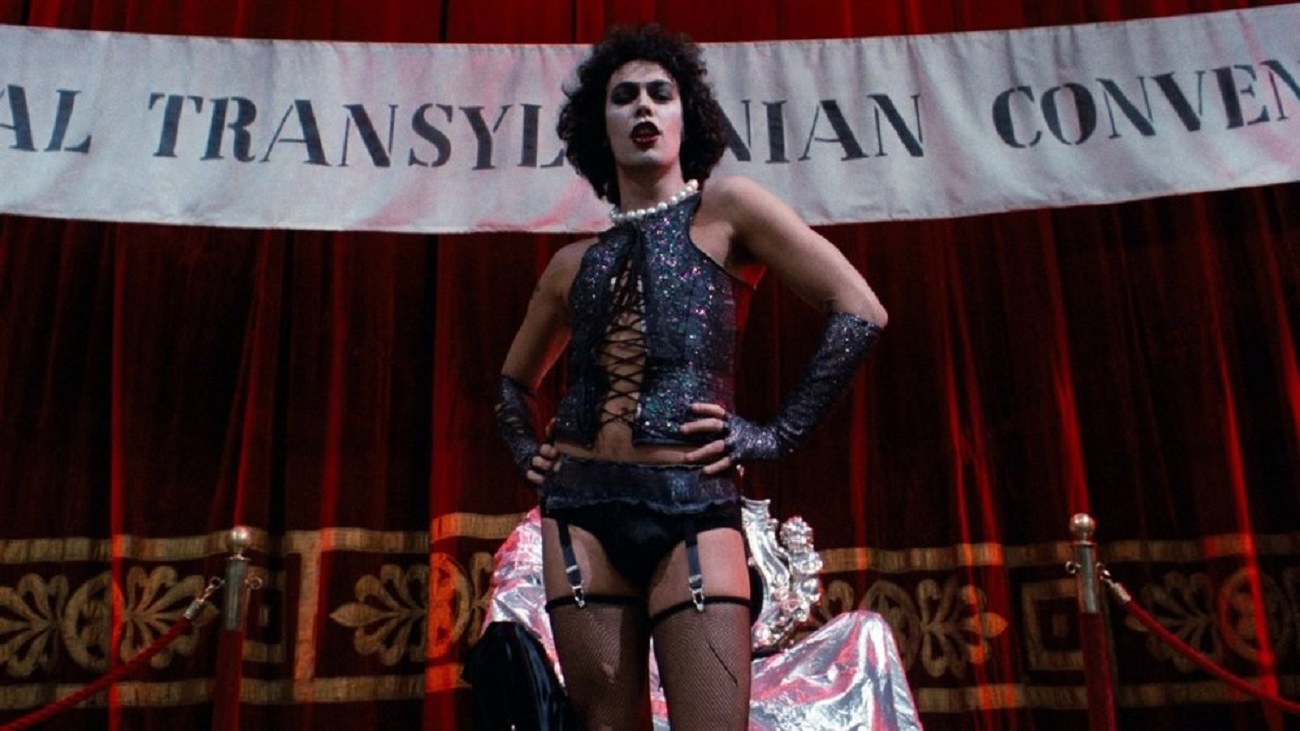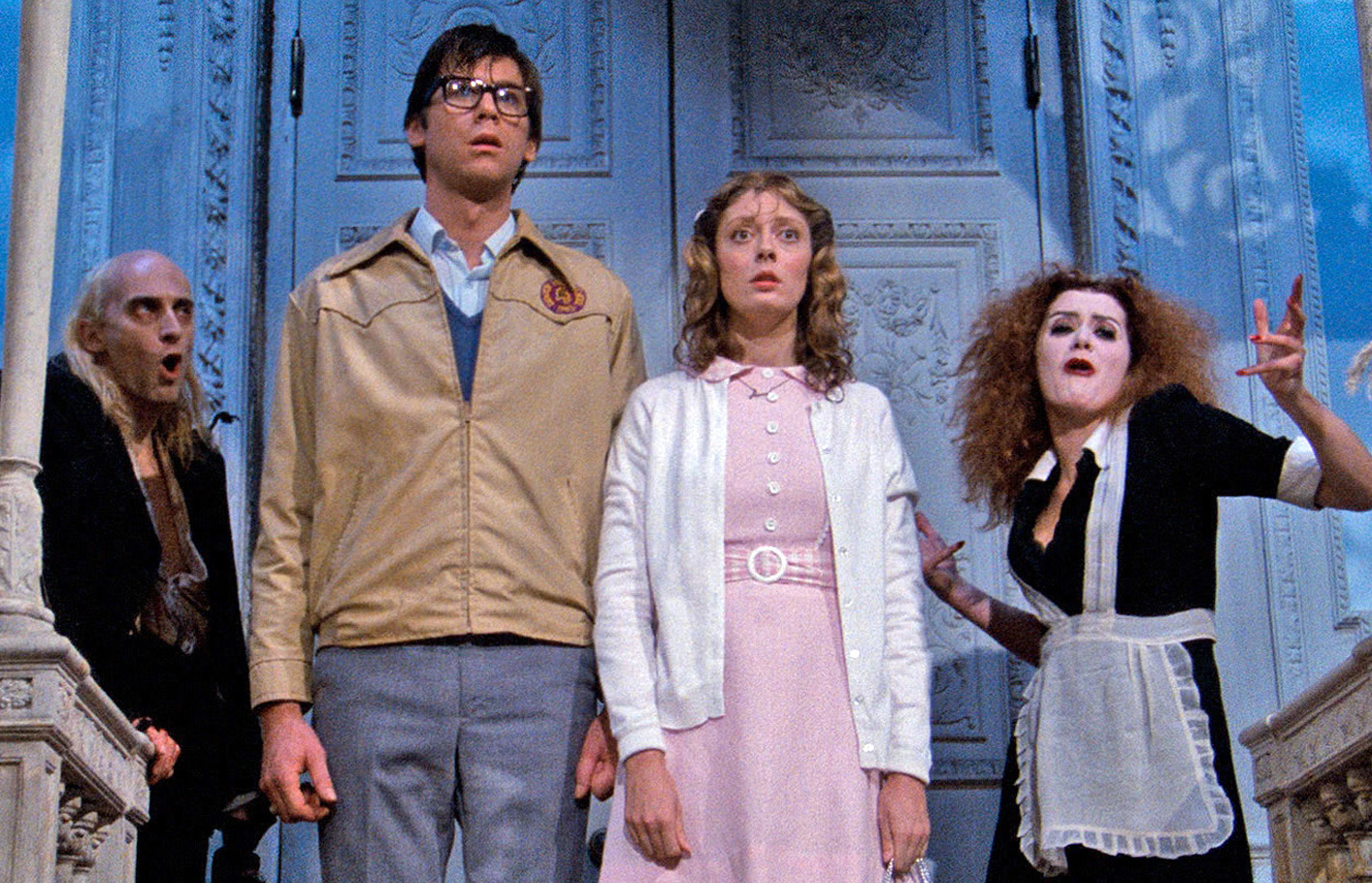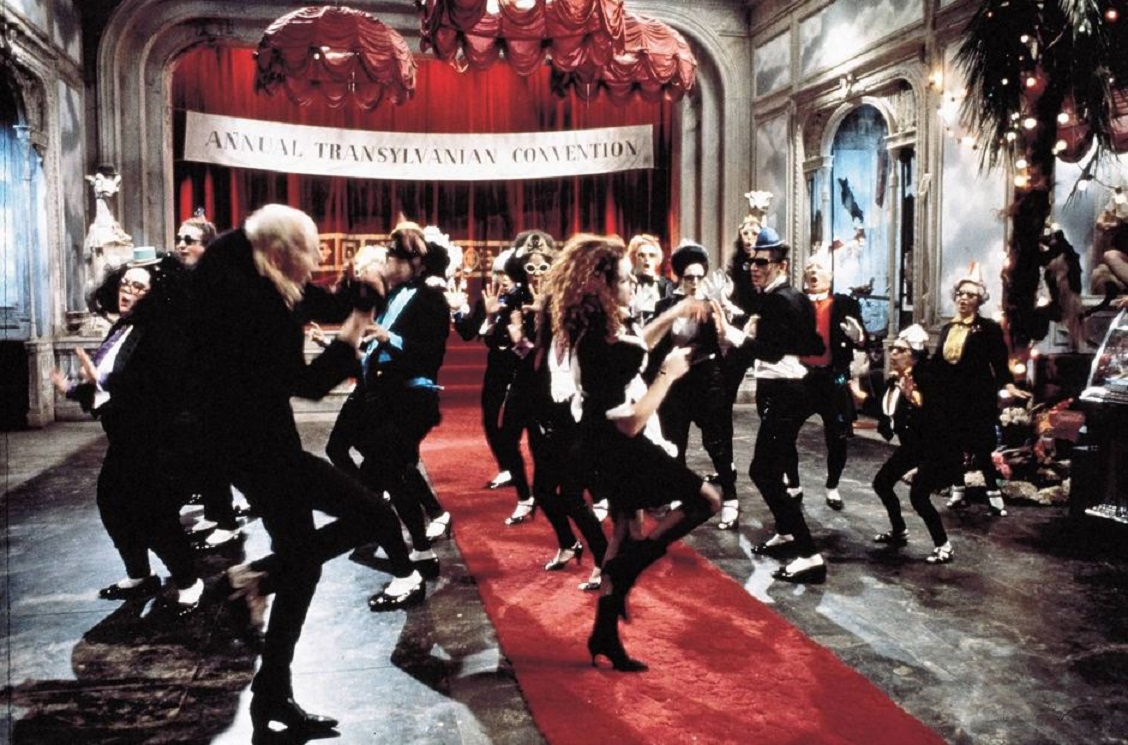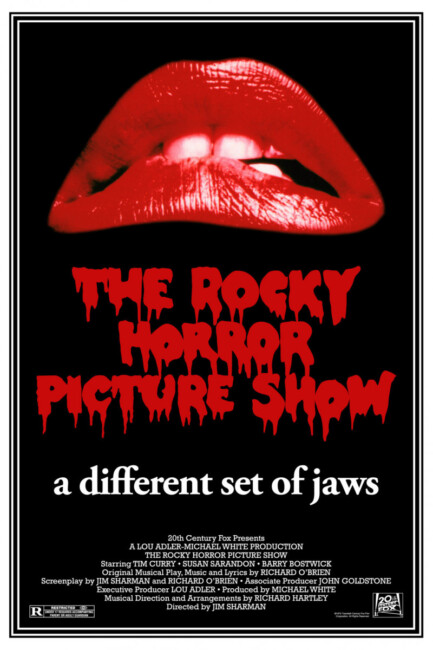Crew
Director – Jim Sharman, Screenplay – Jim Sharman & Richard O’Brien, Based on the Musical The Rocky Horror Show by Richard O’Brien, Producer – Michael White, Photography – Peter Suschitzky, Music – Richard Hartley, Songs – Richard O’Brien, Special Effects – Wally Veevers, Makeup – Peter Robb-King, Art Direction – Terry Ackland-Snow, Choreography – David Toguri. Production Company – 20th Century Fox.
Cast
Tim Curry (Dr Frank N. Furter), Barry Bostwick (Brad Majors), Susan Sarandon (Janet Weiss), Richard O’Brien (Riff-Raff), Patricia Quinn (Magenta), Little Nell (Columbia), Peter Hinwood (Rocky), Charles Gray (Criminologist), Meatloaf (Eddie), Jonathan Adams (Dr Everett Scott)
Plot
Brad Majors and Janet Weiss announce their engagement. Their car breaks down in the middle of a thunderstorm and they are forced to seek refuge at a nearby castle. This happens to be the lair of the transvestite mad scientist Dr Frank N. Furter, an alien from the planet Transylvania. Frank N. Furter invites them to witness the unveiling of his artificial creation – a blonde muscle-builder built for relieving his sexual tension. He makes them his captives and throughout the course of the night seduces both Brad and Janet and forces them to take part in his transsexual orgies.
The arguments still rage whether The Rocky Horror Picture Show is a cult masterpiece or seventies trash, but no matter what one’s opinion it does notthing to stop Rocky Horror from being the numero uno cult film of all time. It is the cult phenomenon that all opinions of The Rocky Horror Picture Show are formed around, as opposed to the film itself. You either celebrate the film for its campy decadent brilliance, attune to the liberating sense of alternate sexuality and find its weirdness a life-changing experience, or else none of it makes sense and you dismiss the cult simply because you can’t understand what people see in the film. It is hard to see Rocky Horror as a film rather than a phenomenon. Indeed, a scan through the User Comments section for The Rocky Horror Picture Show at the Internet Movie Database shows that people are evenly divided in their liking/hating of the film based almost entirely on those who celebrate the party atmosphere and between those who have a homophobic reaction to it.
The Rocky Horror Picture Show phenomenon grew out of the mind of actor Richard O’Brien. O’Brien created the stage show The Rocky Horror Show, which premiered in London’s Chelsea district in 1973 and starred several of the actors in the film, including Tim Curry and Little Nell. It was a modest hit on the stage, although fared dismally when promoter Lou Adler tried to take it to the US. Adler nevertheless managed to mount the film production but this was a resounding flop when it premiered in 1975. Every single critic at the time trashed it and nobody understood it. That did not stop a small group of followers returning to see it and an audience slowly growing as the film expanded out onto the midnight circuit.
In their exhaustive study of the The Rocky Horror Picture Show cult in their book Midnight Movies (1983), J. Hoberman and Jonathan Rosenbaum place the origin of the phenomenon with Louis Farese Jr sometime in 1976. At a screening, when Susan Sarandon places a newspaper over her head during the rainstorm sequence, Farese is supposed to have shouted back at the screen: “Buy an umbrella, you cheap bitch.” Hoberman and Rosenbaum credit most of the rest of the phenomenon with New York actor and greeting card caption writer Sal Piro.

Since then theatrical screenings of The Rocky Horror Picture Show have developed into a ritual that is repeated all over the world. Audiences turn up dressed as characters from the film, usually crossdressed in the lingerie that Tim Curry affects throughout the show. People dance in the aisles and sing along with the songs. Props are brought along to be used at certain points in the film – thus rice is thrown during the wedding scene; when the thunderstorm occurs, audiences spray one another with water pistols; when Tim Curry “proposes a toast” everybody throws pieces of toast into the air; when the number There’s a Light comes on everybody produces cigarette lighters or flashlights, and so on. There is also the interactive dialogue where audiences shout back comments or insert puns and witticisms in relation to various happenings on the screen – this has become such a huge part of the phenomenon that an audience participation record was even released.
The phenomenon is one of the most unique forms of interactive theatrical experiences ever to emerge. You could compare The Rocky Horror Picture Show to other science-fiction films and tv shows that have developed fanatical cults – two close examples might be Star Trek (1966-9) and Star Wars (1977). While both have conventions and theatrical screenings where large numbers of fans turn up dressed as the characters from the films, public screenings have never developed into something akin to a mass where audiences respond in a ritualised way to the events as they take place on the screen.
The Rocky Horror Picture Show came out just when the genre spoof was beginning as a phenomenon. A few years either side of Rocky Horror saw genre parodies such as Flesh Gordon (1974), Schlock (1973), The Phantom of the Paradise (1974) (which has many similarities to Rocky Horror) and Young Frankenstein (1974). There had also been the popularity of the ultra-campy tv series Batman (1966-8) and a few years later would see the success of Star Wars, which popularised the fad for remaking, recycling and in-referencing 1950s B sf movies.

The opening song Science Fiction Double Feature is essentially a nostalgic ticklist of favourite genre movies from Richard O’Brien’s childhood and includes references to Doctor X (1932), The Invisible Man (1933), King Kong (1933), The Day the Earth Stood Still (1951) and Forbidden Planet (1956) and lines including “Flash Gordon was there in his silver underwear … When I saw Janette Scott fight a Triffid that spits poison and kills … Dana Andrews said prunes gave him the runes,” [the latter two being references to The Day of the Triffids (1962) and The Curse of the Demon/The Night of the Demon (1957)]. Throughout, the film is littered with visual B movie references – Magenta sports a beehive hairdo after Elsa Lanchester in Bride of Frankenstein (1935), while Tim Curry has ‘Love’ and ‘Hate’ tattooed on alternate knuckles just like Robert Mitchum in The Night of the Hunter (1955). There is also an elaborate recreation of the RKO Radio Pictures tower logo that Tim Curry climbs at the end, not unakin to RKO’s most famous creation – King Kong.
TV’s Batman was about taking a po-faced comic-book hero and letting them lose their innocence by sending up the inherent silliness. Both Barbarella (1968) and Flesh Gordon were about comic-book heroes like Flash Gordon losing their innocence in the most literal sense. In turn, The Rocky Horror Picture Show is about the Frankenstein movie losing its innocence. It is a Frankenstein movie that has been put through the giddy silliness of Batman and combined with gender-bender glitter rock of the 1970s as popularised by the likes of David Bowie – the mad scientist lets his kinks hang out; rather than create a perfect human, he creates a bodybuilder for his own sexual purposes; while both the starchy upright hero and heroine end up being plundered in the most direct ways when they stumble into the mad scientist’s lair.
All of this celebrates a surprisingly open poly-sexuality. The Rocky Horror Picture Show is one of the very few American films that comes out and says that sex, including bisexuality and moderately alternate practices such as cross-dressing, is fun. It even features a ray device that forces starchy straight people to become cross-dressed in lingerie and suspenders. It does end on a note that is mildly disapproving of too much excess, but the rest of the show is a surprisingly candid and forthright celebration of allowing vive la difference to emerge unfettered. As the film’s poster, simply a large pair of lips, promises “Don’t dream it. Be it.” It is a good deal of amazingly silly, but surprisingly good-natured and harmless fun. The plotline meanders and does wind down by the pool orgy scene, but there is such a demented energy present that it manages to carry everything else throughout.

The Rocky Horror Picture Show: Let’s Do the Time Warp Again (2016) is a tv movie remake featuring real-life trans actress Laverne Cox as Frank N. Furter with Tim Curry also appearing as The Criminologist. There have been several attempts to create a sequel to Rocky Horror, most of which have floundered due to Tim Curry’s unwillingness to return to the part. The only one of these that ever emerged was Shock Treatment (1981), a rather slight satire on tv and mental health with some good songs, which never came anywhere near replicating the cult success of the original and is generally looked down on by Rocky Horror cultists. The stage show is regularly revived all over the world – one such revival in New Zealand in 1986 featured the novelty of former Prime Minister Robert Muldoon playing the criminologist.
Jim Sharman has made four other films, including Shock Treatment. All of these were made in Sharman’s native Australia and are obscure. Prior to The Rocky Horror Picture Show, Sharman made the 16 mm Shirley Thompson Versus the Aliens (1972), a bizarre film about a housewife who encounters aliens that animate a statue of the Duke of Edinburgh. Sharman later made Summer of Secrets (1976), an arty mad scientist film that, unlike Rocky Horror, plays the themes straight, and the non-genre black comedy The Night, the Prowler (1978). Richard O’Brien makes minor appearances as an actor in various films and can be spotted everywhere from Derek Jarman’s Jubilee (1978), the remake of Flash Gordon (1980) to Dark City (1998), EverAfter (1998) and Dungeons & Dragons (2000). He has never written any other scripts, but did contribute the songs to the Australian-made superhero spoof The Return of Captain Invincible (1983).
Trailer here


